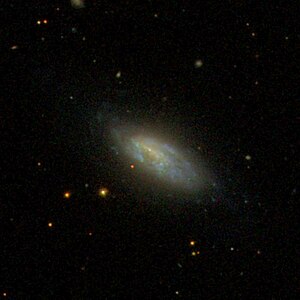NGC 3659
| Galaxy NGC 3659 |
|
|---|---|

|
|
| SDSS recording | |
| AladinLite | |
| Constellation | lion |
|
Position equinox : J2000.0 , epoch : J2000.0 |
|
| Right ascension | 11 h 23 m 45.5 s |
| declination | + 17 ° 49 ′ 07 ″ |
| Appearance | |
| Morphological type | SB (s) m? / HII |
| Brightness (visual) | 12.2 mag |
| Brightness (B-band) | 12.8 mag |
| Angular expansion | 2.3 ′ × 1.3 ′ |
| Position angle | 60 ° |
| Surface brightness | 13.2 mag / arcmin² |
| Physical data | |
| Affiliation | NGC 3607 group NGC 3626 group NGC 3686 group LGG 237 |
| Redshift | 0.004287 ± 0.000018 |
| Radial velocity | 1285 ± 5 km / s |
|
Stroke distance v rad / H 0 |
(54 ± 4) · 10 6 ly (16.7 ± 1.2) Mpc |
| history | |
| discovery | William Herschel |
| Discovery date | March 14, 1784 |
| Catalog names | |
| NGC 3659 • UGC 6405 • PGC 34995 • CGCG 096-038 • MCG + 03-29-040 • IRAS 11211 + 1805 • 2MASX J11234549 + 1749068 • GC 2399 • H II 53 • h 878 • HIPASS J1123 + 17 • LDCE 778 NED037 | |
NGC 3659 is a low luminosity barred spiral galaxy with extensive star formation from Hubble type SB m in the constellation Leo on the ecliptic . It is estimated to be 54 million light years away from the Milky Way and about 40,000 light years in diameter.
The galaxies NGC 3626 , NGC 3639 , IC 685 are located in the same area of the sky .
The object was discovered by Wilhelm Herschel on March 14, 1784 .
